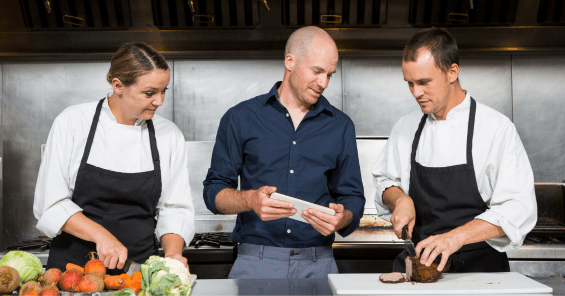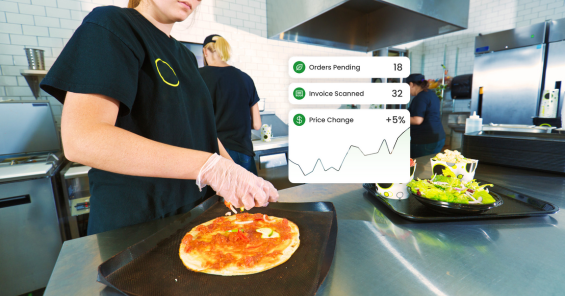

POS & Accounting Integrations for Restaurants: How MarketMan Simplifies Inventory, Cost Control & Reporting in 2025
Discover how seamless POS and accounting software integrations streamline restaurant operations in 2025. Learn how MarketMan helps reduce costs, save time, and scale with confidence.
Turning Data Chaos into Control
Running a restaurant in 2025 means managing a constant stream of data: sales from the POS, invoices from suppliers, inventory counts, and financial reports. But when those systems don’t talk to each other, chaos follows. Managers spend hours re-entering numbers, chasing discrepancies, and waiting until month-end to understand food costs.
That’s why POS and accounting integrations have become essential, not optional. When these systems are connected to your inventory management platform, every sale, recipe, and invoice updates automatically. Operators gain instant visibility into real-time food costs, waste, and profitability.
With MarketMan, POS and accounting integrations go beyond basic syncing. They create a single source of truth for your restaurant’s financial and operational data, helping teams reduce costs, speed up reporting, and scale with confidence.
Why POS Integrations Are the Missing Link
Every restaurant runs on its POS, it’s the heartbeat of daily front of house operations. But for too many operators, the data stops there. Sales live in one system, invoices pile up in another, and accounting lags behind. That disconnect leaves managers scrambling to reconcile numbers instead of focusing on service and profitability.
For operators, this story is painfully familiar. According to the National Restaurant Association (NRA), over 40% of restaurants still manually transfer data between systems, leading to hours of wasted time and frequent errors. Those inefficiencies might seem small, but in an industry where margins are already razor thin, they’re costly.
The National Restaurant Association data shows full-service restaurants report a median before-tax profit margin of just 2.8%, while limited-service restaurants average 4.0%. Labor remains the largest single expense, accounting for 36.5% of sales in full-service operations.
And costs keep rising. The “food away from home” index increased 3.9% year over year in August 2025, while the meats, poultry, fish, and eggs index rose 5.6%. Wholesale beef prices alone climbed 4.6% in recent months.
The answer? Seamless integrations. When your POS, accounting, and inventory tools talk to each other automatically, you eliminate manual mistakes, speed up reporting, and protect profits in a high-cost, high-pressure environment.
The Pain Points That POS Integrations Solve in 2025
1. Razor-Thin Margins
Without POS integrations, every reconciliation is manual. With net margins averaging just 2.8–4.0%, every error or inefficiency makes an outsized impact. Manual reconciliations cost operators both money and time they can’t spare.
2. High Food Costs and Waste
When POS data isn’t connected to inventory and accounting, costs are hidden until it’s too late. The food index continues to climb, with proteins particularly volatile. Without real-time tracking, over-portioning, waste, or unnoticed vendor price hikes quietly eat away at margins.
3. Manual Processes
Disconnected POS systems force operators into spreadsheets. Paper invoices and siloed POS data mean hours of re-entry instead of leadership. Errors are inevitable, and delays hide problems until it’s too late.
4. Staff Turnover and Training
A non-integrated tech stack makes onboarding harder. With annual turnover exceeding 70% across the industry, back-office systems must be simple enough for new staff to pick up quickly. Software designed for accountants or “Excel experts” doesn’t fit the restaurant reality.
5. Disconnected Tools
When POS, accounting, suppliers, and payroll don’t talk, operators become the middleman. They’re left patching together reports and fixing mismatches instead of running the business.
Why POS Systems Are Central to Integration Success
Not all POS systems are created equal, but nearly all of them are powerful gateways for restaurant data. Many leading POS platforms, including: Toast, Square, Lightspeed, Revel, and Clover, already have incredible domain authority, robust user adoption, and trusted integrations. They handle millions of transactions daily, which means the quality of their data can make or break back-office accuracy.
MarketMan partners with many of these POS leaders to ensure operators aren’t locked into a single ecosystem. Whether you’re a single-unit cafe or a multi-location group, choosing a POS with strong integration capabilities means your sales data flows directly into inventory, accounting, and supplier systems without manual entry. The result? Operators move from firefighting to foresight.
Why Seamless POS Integrations Matter More in 2025
Integrations aren’t new, but they’re more critical than ever.
- Inflationary Pressure: With food costs up nearly 4% year over year, operators can’t afford to wait until month-end to see their COGS.
- Labor Shortages: Less admin staff means more back-office tasks fall on managers who already wear too many hats.
- Faster Growth: Chains expanding from 5 to 15 units can’t scale on spreadsheets.
- AI Adoption: Competitors are already using AI for invoice scanning and AI ordering. Falling behind means operating blind.
How Integrations Solve the Big Pain Points
1. Protect Margins
- Real-time syncing means daily visibility into food costs.
- Vendor overcharges are flagged immediately.
- Month-end surprises disappear.
With MarketMan: Operators typically see 5% food cost savings
2. Control Food Costs & Waste
- POS sales connect directly to recipe costing.
- Waste, comps, and over-portioning become visible in real time.
- Costs flow straight into P&L reporting.
Case in Point: By integrating its POS, accounting, and supplier data through MarketMan, Hello Nori gained real-time visibility into costs and dramatically reduced waste across its operations.
3. End Manual Processes
- AI invoice scanning turns photos into line-item accuracy.
- No more re-keying or correcting mismatched totals.
- Staff can focus on service, not spreadsheets.
Cafe Crepe cut inventory time by 85%, saving managers hours every week.
4. Simplify Training Amid High Turnover
MarketMan’s interface is intuitive, built for chefs and operators. Staff can be trained in minutes, not days.
5. Scale Confidently
- Multi-location operators get consolidated reporting.
- Corporate teams gain transparency across units.
- Growth doesn’t require hiring extra admin staff.
MarketMan’s Role: Operator-First, Not Accounting-First
Competitors often build integrations with finance teams in mind. MarketMan is built for operators by operators:
- POS Integrations: Sales data flows directly into MarketMan for recipe-level insights.
- Accounting Integrations: QuickBooks, Xero, and others connect seamlessly.
- Supplier Integrations: Orders, deliveries, and invoices sync automatically.
- AI Invoice Scanning: Upload an invoice photo; MarketMan handles the rest.
Unlike accounting-heavy solutions that focus on reporting, MarketMan drives real results where restaurants feel it most; in food cost control, waste reduction, and time saved across every shift.
ROI Snapshot
MarketMan customers consistently see measurable results that directly impact profitability:
- 100+ hours saved every month on back-office tasks.
- 5% reduction in food costs through real-time visibility and control.
- Cut inventory time by 85%, turning hours into minutes.
For restaurants operating on margins under 5%, these numbers aren’t just improvements; they’re game-changers.
Ready to see these results in your business? Book a demo with MarketMan today
Educational Guide: How to Evaluate Integrations
Operators shopping for software should ask:
- Does it remove manual entry? Or just shift it?
- Is it built for operators? Or accountants?
- Does it scale with growth? From 1 to 20+ units?
- Is there proof? Case studies, not vague claims.
The Future of Restaurant Integrations
2025 marks a major shift in how restaurants use technology. Integrations are no longer just about syncing systems, they’re about predicting what comes next.
AI-driven ordering anticipates demand before it spikes.
AI invoice scanning eliminates manual work and catches discrepancies instantly.
MarketMan is leading this transformation, building connected systems that give operators foresight, not just hindsight. As integrations evolve, platforms like MarketMan aren’t just connecting data, they’re empowering restaurants to operate smarter, leaner, and more profitably than ever before.
For operators facing rising costs and limited time, these gains aren’t luxuries, they’re lifelines.
Tired of reconciling spreadsheets, chasing numbers, and wasting hours on manual entry? Book a demo with MarketMan today to see how seamless POS and accounting integrations help you cut costs, save time, and scale confidently.
FAQs
How does POS integration help restaurants?
It connects sales data directly to inventory and accounting systems, eliminating manual entry and giving real-time COGS visibility.
What is the best accounting software for restaurants?
QuickBooks and Xero are industry staples, but their true value comes when connected to inventory systems like MarketMan.
Do integrations matter for small restaurants, or just chains?
Both. Single-unit operators save hours weekly; multi-unit operators gain scalability.
What’s different about MarketMan integrations?
They’re designed for operators, not accountants, combining POS, accounting, and supplier connections with AI accuracy.
Author
Contributors
If you have any questions or need help, feel free to reach out
Don't miss out on maximizing your restaurant's profits! Calculate your ROI with MarketMan







